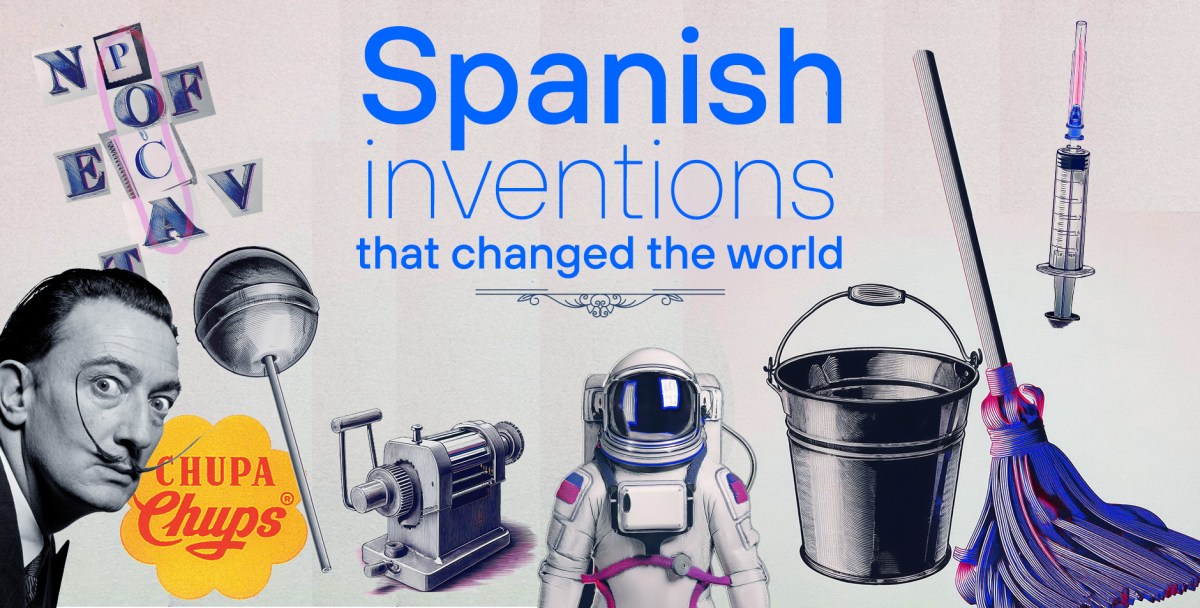- Mops, Chupa Chups, table football… However, not all Spanish inventions involve ‘putting sticks in things’.
- The famous Chupa Chups logo was designed by Salvador Dalí.
- What is the connection between a bombing during the Civil War and table football?
Other countries have their own inventor’s days, beyond the International Day of 9 November. However, this is not the case in Spain.
We are going to present some candidates that could have this honour thanks to some creations of Spanish origin that have reached all corners of the earth, as have other great inventions in the history of mankind.
Mop and disposable syringe: Manuel Jalón
Not without controversy over authorship, although the courts have recognised him as such, Manuel Jalón (1925-2011), a native of La Rioja who lived in Zaragoza, is considered to be the inventor of the mop.
The Spanish Patent and Trademark Office recalls that ‘there are dozens of previous patents describing the idea of mopping with fibre glued to a stick that drains into a bucket’, although it recognises that the models patented by Jalón between 1957 and 1964 ‘acquired well-deserved fame and extensive use’.
This engineer and Air Force officer observed during a stay in the United States how in military hangars the floor was cleaned with a flat mop and a bucket with rollers, the origin of his invention.
Another of Jalón’s inventions is the disposable syringe, a great advance in the world of medicine that in 1975 came to help overcome the difficulties presented by the glass syringes that had been in use all his life.
Lollipops: Enric Bernat
The lollipop is a Spanish invention that was born in 1958 known as Gol, being simply called Chups in 1960, although from 1963 it changed to its current and well-known name thanks to an advertising jingle.
Enric Bernat (1923-2003) came from a family of confectioners and in 1958 he launched a candy joined by a stick with the incentive that whoever consumed it would not stain their hands with the sweet.
As a curiosity, the company’s logo dates from 1968 and was designed by the surrealist artist Salvador Dalí, who took less than an hour to create the design.
The success of this candy on a global scale exceeds its presence in practically every country on earth (officially, it was already present in 164 countries in 1990, according to the company’s own data). In 1995, it reached the milestone of being the first candy to be consumed in space: specifically, by Russian astronauts on the MIR station.
Alphabet soup: Pedro Ocón de Oro
Pedro Ocón de Oro (1932-1999) is responsible for the creation of no less than 600,000 pastimes.
Among them, alphabet soup, a famous grid filled with different letters to form words. However, there are theories that attribute the invention of this popular game to the American Norman E. Gibat. As neither of them patented it, there is no official ruling on authorship.
In any case, the creator of hieroglyphs, crosswords and other similar games published in specific books or in the ABC newspaper, this Madrid-born man even showed graphically where he got the inspiration for these pastimes. He answered the question of how he came up with them with a simple black letter ‘u’ on a white background, a play on words that there is only one ‘u’ with which he wanted to say ‘I use my mind’.
Table football: Alejandro Finisterre
The Galician Alejandro Campos (1919-2007), better known as Alejandro Finisterre as he was born in this town in A Coruña, is the creator of table football.
The curious origin is to be found in the Civil War, since after being buried after a bombing over Madrid in 1936 and being wounded, he saw that many people were in the same situation, and inspired by table tennis, he created table football together with a carpenter friend.
The invention was patented in 1937 in Barcelona, although he was unable to commercialise it because of his affinity with the Republican side and because he had to go into exile with Franco’s triumph.
On his return from exile decades later, Finisterre was surprised by the acceptance and popularity of these small football players inserted in bars.
As a curiosity, Finisterre also invented the first sheet music sheet holder that worked with the foot, an idea he developed for a pianist with whom he was in love.
Table stapler: Juan Olave and Juan Solozábal
Although the origin of the stapler dates back to the 18th century in the France of Louis XV, it was patented in 1866 by the American George W. McGill in 1866, who perfected it himself and reduced its size, as well as adding a strip of staples that did not need to be reloaded after each use, in 1879.
Following in the wake of McGill’s patents, two Basque entrepreneurs in the arms industry, Juan Olave and Juan Solozábal, turned to the manufacture of office supplies.
The office models of the stapler were born under the name of ‘cosepapeles’, although their creators did not lose their origins in the world of weapons, as they declared that ‘a staple should pass through the stapler with the same precision as a bullet through the barrel of a revolver’.
Hand-cranked pencil sharpener: Ignacio Urresti
Originating in the same factory in the Gipuzkoa town of Eibar de El Casco as Olave y Solozábal, in 1945 Ignacio Urresti designed a hand-cranked pencil sharpener (also known as a pencil sharpener, pencil sharpener or pencil cutter). This device weighed more than a kilo and was copied all over the world, being the origin of the desktop pencil sharpener.
However, the first patent for the pencil sharpener is attributed to the French mathematician Bernard Lassimone in 1828. Almost 20 years later, the French nobleman Thierry des Estivaux developed the first hand-held pencil sharpener, consisting of a tube, a cone and fitted with a blade.
Astronaut suit: Emilio Herrera
The astronaut suit, which was essential to the development of the space race, was created in 1935 by Emilio Herrera Linares (1879-1967), a military and aerospace engineer from Granada.
This forerunner of the spacesuit was pressurised and known as the stratospheric suit, and was to be tested in a stratospheric suit in a hot-air balloon.
However, the outbreak of the Spanish Civil War cut the flight short. As a curiosity, this is not the only link with the war, as Emilio Herrera was even president of the Republican government in exile for a short period of time.
But back to the suit, it had a watertight cover with an articulated metal frame with accordion-like folds for shoulders, elbows, knees, fingers and hips.
This aviation enthusiast had already made history in 1914 when he flew with José Ortiz Echagüe for the first time over the Strait of Gibraltar on a route between Tetuán and Seville, the first between Europe and Africa.
The calculator and cable car: Leonardo Torres Quevedo
The Cantabrian Leonardo Torres Quevedo (1852-1936) is one of the great names of inventions in Spain, even linked to the world of robotics, having created in 1912 an automaton capable of playing chess.
Even at Niagara Falls, a ferry of his creation has been in service since 1916, crossing people over the water. In fact, the name is Spanish Aerocar. It is currently the oldest cable car in the world in operation, and has the curiosity that, although it departs from and arrives on Canadian soil, it crosses the border between Canada and the United States four times.
A few years earlier, Torres Quevedo had been a pioneer with the first cable car for passenger transport. Specifically, it was inaugurated in 1907 in San Sebastián.
This renowned inventor was also responsible for a device called the electromechanical arithmometer, an electromechanical calculating machine, the first of its kind and presented in 1920. Although it is true that there are other previous calculating machines, Torres Quevedo’s is considered the pioneer of the automatic calculator used today.
Portable X-ray machine: Mónico Sánchez
Mónico Sánchez (1880-1961) was an inventor and engineer from La Mancha known for having created a portable X-ray and high-frequency current machine in 1909.
Based in the United States since 1904, Sánchez invented this device, which weighed 10 kg compared to 400 kg for traditional devices. The device became extremely popular during the First World War (1914-1918).
From humble origins in the town of Piedrabuena in the province of Ciudad Real, Sánchez achieved such a level of fame that in New York he rubbed shoulders with Edison and Tesla.
After having travelled the Americas, in 1912 he returned to Spain as a successful entrepreneur and businessman.
Autogiro: Juan de la Cierva
The Murcian Juan de la Cierva (1895-1936) is responsible for the creation of the autogyro, a flying machine that was the precursor of the helicopter.
After researching numerous rotor fundamentals, De la Cierva made the gyroplane fly more than 200 metres in 1917 and a year later he managed to make a trip between the aerodromes of Getafe and Cuatro Vientos, in Madrid.
However, the development and improvement of the helicopter meant that the gyroplane fell into oblivion.
Electric submarine: Isaac Peral
The Cartagena-born Isaac Peral (1851-1895) was responsible for the creation of the first electrically powered torpedo submarine.
Launched in 1888 in the Cadiz town of San Fernando, the submarine known as the Peral Submarine had a range of 66 hours and a range of 284 nautical miles (equivalent to 511 kilometres).
This first battery-powered submarine was a great innovation at the end of the 19th century and opened the door to the submarines of the 20th century.









